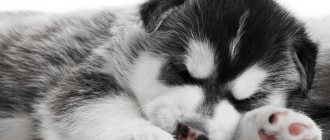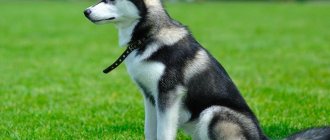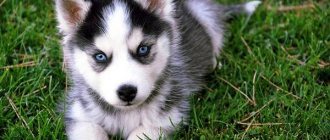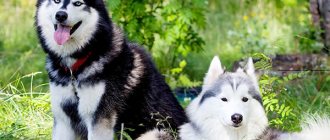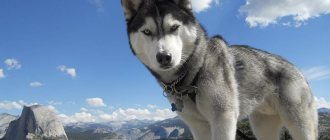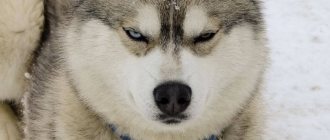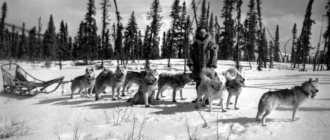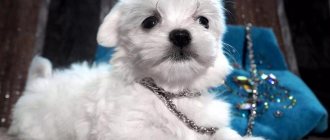| Type |
|
| Size | medium (11-25kg) |
| Main features |
|
| Included in |
|
| Frequent illnesses |
|
| Intelligence | 80% |
These dogs surprise, charm, and sometimes disappoint. Fleet-footed Huskies can deliver loads, win running competitions and bring joy to everyone around them. A variety of emotions are reflected on their crafty faces, they frown and smile, look down and squint like cats. In addition, the Siberian Husky is a truly legendary breed that deserves respect. Its long history has had tragic and heroic pages.
According to those who are disappointed in the breed, these same dogs are real devils and a bitter punishment for the owner. Due to their irrepressible energy, enterprise and agility, huskies have gained notoriety. They are considered home destroyers, incorrigible fugitives and troublemakers.
Why does the same breed of dog delight some people and upset others just as much? Let's take a closer look at the ugly and adorable huskies.
History of the Siberian Husky breed
Husky is one of the oldest breeds, according to some estimates, it is more than four thousand years old. Back in the Neolithic era, the tribes that then inhabited the northeast of modern Russia domesticated the wild wolf. The first dogs began to help their owners hunt, and later they were adapted to transport goods.
Around the turn of the 17th and 18th centuries, Russian merchants and travelers met Siberian huskies. They told and wrote that the Chukchi actively use teams of nine sled dogs on their farms. The guests began to order the transportation of goods to local residents and began to master the skill of driving special sleighs and sleds themselves. For a long time, sled dogs were the only means of transportation over long distances in the regions of the Far North. The animals were distinguished by their endurance, good health, and thanks to their thick fur with a rich undercoat, they could easily withstand harsh climates. In addition, huskies were distinguished by a very peaceful character, they worked well in a team and did not start quarrels or fights with their sled mates.
The northern peoples were very respectful of their four-legged helpers. They tried to take care of them and not overload them. The Chukchi only transported things on sled dogs, and they themselves very rarely allowed themselves to ride on sledges, but walked alongside them. Only children, old people or sick family members could become passengers. In addition, the Chukchi believed that a person who mistreats a husky will be punished in the afterlife. According to their ideas, the gates of “paradise” are guarded by two dogs.
The development of northern Siberia changed the lives of indigenous peoples. They began to be pushed out to less populated areas. But in Tsarist Russia, sled dogs were still held in high esteem. At the end of the 19th century and the beginning of the 20th, Siberian husky teams were in great demand among Russian merchants. And in order for the animals to cope better with heavy loads, the sleds were “harnessed” not by nine dog forces, but by 25 or more. At the same time, the first representatives of the breed came to the neighboring continent - North America. Alaska, where the gold rush began, was in dire need of a live form of transport. So huskies came to the US court, and this circumstance turned out to be extremely useful for the breed. As a result, it is the United States that is recognized by cynologists as the homeland of dogs that were domesticated by the Chukchi. Learn more about another native dog breed - the Japanese Ainu
The word "husky" is a corruption of the name of the northern Eskimo people. English-speaking sailors pronounced it in their own way, it sounded like “huskimos”. At first, this was the name given to the original Eskimo dogs. And when furry immigrants from Chukotka appeared in Alaska, they were called Siberian huskies.
The Huskies turned out to be of no use to the Land of Soviets. The leaders of the USSR decided that sled dogs would not be useful to the national economy. They can easily be replaced by snowmobiles, trains and cars. But then it turned out that the reindeer herders still needed help. Then it was decided to artificially breed breeds that would specialize in deer herding, hunting and transporting heavy loads. However, Soviet dog handlers excluded huskies from selection. They considered them too small and weak for such work. By the time the USSR collapsed, there were no representatives of the breed left in Russia.
However, in the United States and Canada, huskies quickly gained popularity, especially in the northern states. Dogs with magnificent appearance and good-natured character were noticed by breeders. They began to work on the speed qualities of animals, organizing sled races for mushers. But special interest in the breed arose after Siberian huskies saved residents of the Alaskan city of Nome from an epidemic.
In January 1925, residents of the town of Nome asked for help. They sent a telegraph saying that diphtheria was spreading in the settlement and a vaccine was urgently needed. At the same time, a severe snow storm began; medicine could only be delivered by dog sled. Then the mercy race started, in which 20 mushers and 150 dogs took part. Norwegian Leonard Seppala and his team, led by a husky named Togo, had the most difficult section. In total, they covered more than 400 kilometers in 30-degree frost and snowstorm. The final stage was carried out by Gunnar Kaasen and his assistant dogs, led by the husky Balto. Thanks to them, the medicine was delivered to Nome. And the dogs’ feat was immortalized; monuments to the fleet-footed and brave Siberian huskies were erected in Alaska and New York. They also made a film about them.
In 1934, the Husky breed was officially recognized and the first standard was adopted. But breeders continued to work to improve the characteristics of these dogs. Some sought to make the dogs even faster and for this purpose crossed them with hounds and cops. As a result, a hitherto unrecognized breed of Alaskan Husky appeared. Formally, these are mixed breeds, but now they are outperforming purebred sled dogs.
Other breeders began to improve the external qualities of the Siberian Husky. This is how the first blue-eyed black and white dog appeared. She made a splash at the exhibition. As a result, huskies have become popular again, but now as pets and companions.
The first representatives of the once lost breed were brought to Russia at the very end of the last century. They quickly attracted the attention of professional dog handlers and dog lovers. And in 2000, more than a hundred Siberian Husky puppies were registered that were born in Russian nurseries.
Basic mistakes in training
Common mistakes in raising a husky that should never be made:
- play with the dog with household items (slippers, clothes, etc.);
- encourage aggression towards other animals;
- prohibit communication with other animals;
- pick up the dog;
- allow guests and strangers to pet and feed the dog;
- show excessive affection and tenderness;
- allow incorrect voice intonation in commands and when encouraging;
- use beatings when punishing;
- forcing the dog to perform the same command for no reason.
Husky breed appearance
The Siberian Husky is a typical sled dog, adapted for long runs and long distances. She is of medium size, maximum height for males is 60 cm. She should not be overweight, maximum 28 kilograms. The figure is proportional, athletic and perfectly balanced. Huskies are especially beautiful in movement; they are characterized by a relaxed and flexible gait.
The head of these dogs is neither too large nor small, but proportional to the body. The transition to the muzzle is very pronounced. The nose can be black in individuals of black, gray or red color, and also brownish, pink or “snowy” in copper and pure white. Lips must be dark. Scissor bite only. The eyes are slightly slanted with an almond-shaped cut. The iris is allowed brown and blue, different eyes and color mixing are the norm for this breed. The husky has a special look - sly, slightly cunning, insightful, but in no way malicious. The pubescent ears stand quite high and close, they are triangular in shape with rounded ends that point straight upward.
How popular Siberian Huskies are in the USA and Canada can be judged by the following fact. These dogs have been chosen as mascots by 12 higher education institutions. In addition, many sports clubs use the name of the breed.
The neck is slightly arched when a husky stands proudly and holds its head high. When trotting, the neck extends forward. The dog's back is smooth and strong, but not stocky. The loin is dry, slightly tucked and much narrower than the chest. The croup is slightly sloping. The thoracic region is quite deep, although not excessively wide. The ribs on the sides become flat. This is important for free trotting. The fluffy tail resembles a fox's. In a state of tension, it is raised above the back like a sickle, but does not lie down or curl into a ring. If the dog is relaxed, the tail will be lowered. Limbs well developed, straight and parallel. The joints are strong, the muscles are strong. The paws are not very large, oval in shape with thick and elastic pads. Hair grows between the toes. The Siberian Husky moves without tension, with an easy gait. When picking up speed, the front and hind legs follow the trail, and the back remains level.
The dog's coat is of medium softness and length. Husky looks moderately fluffy. The thick top hair is even and lies smoothly on the body. The undercoat is very dense and soft; during the molting period it may become thinner. Trimming for a neat appearance can only be done on the paws and between the toes. The fur on other parts of the body should not be touched. The color of Husky dogs is very diverse. It ranges in color from black to snowy white, with markings on the head and various patterns on the body allowed.
Disadvantages of the exterior include deviations from proportional build, excess weight, rough, like a weightlifter, or too light, like a sprinter, bone structure, height above the maximum. Defects are considered to be an incorrect structure of the head, too small or large, poorly defined feet, a rough muzzle, problems with bite, squint, large and drooping ears. Also deducted for a short or elongated neck, a weak and uneven back, a barrel chest, a curled or thrown tail, non-parallel legs, club feet and an awkward gait with a frequently changing rhythm. Hairy and trimmed dogs also have no chance of winning in the show ring.
Husky characteristics: description of the dog
What does a husky dog look like? This is an animal of medium height with beautiful hair and thick undercoat, so at home you cannot do without a brush. This dog does not have the same smell as others, which makes it a desirable pet at home.
- A male husky has a height at the withers of up to 0.6 m and a weight of up to 28 kg.
- The husky girl is shorter - up to 0.56 m and weight up to 23 kg
Concerned about something
Dogs that are too tall, short, obese or thin are rejected in show competitions, while these parameters are not important in racing. Which, of course, doesn’t stop them from remaining your favorite pets in your home.
Yes, the smell of a husky is almost unnoticeable, but if you live in a local area with hot summers, then most likely you will have to cool the dog down in the shower. And then the smell may intensify for a short time. But as the animal dries out, it will return to normal.
Odd-eyed husky
The husky has a medium head with triangular ears, a high neck, and a wide and powerful chest. The eyes are almond-shaped, blue or brown. Odd-eyed huskies are also included in the breed standard. The tail resembles a fox's. Without creases or twists in a calm state. The dog's movements are light and graceful.
Husky puppy
The husky's exterior is perfectly adapted to life in the north, so they get hot in warm regions. A husky needs to be accustomed to trimming, otherwise in the summer he will suffer from the heat, and you will suffer from his ubiquitous fur.
Character of the Siberian Husky
The Siberian Husky has a friendly disposition and a calm, but at the same time lively, sanguine temperament. This is a kind, affectionate and completely non-aggressive dog. He treats people and dogs around him kindly, does not start fights or quarrels, but is always ready to run and play. These character traits made the husky an excellent companion. Usually he chooses one of the whole family as his master. However, he maintains even friendly relations with others.
Dogs of this breed have not forgotten their sledding past. They, like their ancestors, love to work, the main thing is to come up with an interesting task for them. A husky will be happy to tow a sled or cart, or drag a skier or roller skater. An agile dog can master agility or another “dog” sport.
But you shouldn’t even try to make a Siberian husky a guard or watchman. They are absolutely not suitable for such work, because they do not know how to show suspicion and distrust. They do not have the territorial sense that most working breeds have. So if you need protection from robbers, you shouldn't get a husky. This good-natured fellow can only scare strangers with his wolf-like outfit, knock them over while jumping for joy, and then lick them until they lose consciousness. By the way, a Siberian Husky is also unlikely to be a hunter. The dog can get prey, but usually does not bring it to the owner. The fact is that sled dogs, the ancestors of the breed, were fed only in the cold season, and in the summer they were taught to look for food on their own. They hunted rodents or birds and immediately ate them.
Huskies are excellent with children. They are on the same wavelength with the kids, they love to play and be naughty and mischievous. But a very young child should not be left alone with an active dog. The dog won’t do anything bad to him, but he may accidentally drop him or scare him.
Huskies are loyal and devoted friends; they really need to communicate with people. And if the owner is gone for a long time, the dog will be sad and bored. This boredom can backfire. If a husky becomes the hero of the movie Home Alone, the comedy can easily turn into drama. The least a dog left to its fate is capable of is a howl that tears apart the souls of its neighbors. Huskies are great at this. If the owner does not respond to the call, the dog may start tearing apart the apartment. You can see many videos on YouTube showing what an energetic and lonely dog can do.
Siberian Huskies do not bark threateningly; they usually make such sounds when they invite someone to play. And they love to howl, with feeling and soul, especially if they gather in company. When just two Siberian Husky dogs howl, it seems like a whole pack is performing.
The Siberian Husky is a curious and intelligent dog that craves new experiences and loves movement. Perhaps it is for this reason that representatives of the breed, especially young ones, run away so often. They're probably getting bored. Huskies can get carried away by something and leave their owner during a walk, or they can run away from home. They show miracles of ingenuity and incredible dexterity when it comes to opening doors or windows. However, in their youth, many dogs tend to go AWOL. And with age, the love of freedom becomes less pronounced, and the dog finally calms down.
Husky care
There is a stereotype that huskies are very difficult to care for. But in fact, the main difficulty is only that the dog needs constant physical and mental stress. In other matters, residents of the far north are quite unpretentious.
Conditions of detention
Although huskies are now often kept in apartments, they are not made for four walls. A dog feels best outside the city when it has its own home and a large area. Otherwise, be prepared to walk the dog for hours and look for places where it can run around to its fullest.
Photo: pet-master.ru
Hygiene
Oddly enough, caring for huskies is quite simple - they don’t even need to be bathed. Moreover, an unpleasant odor often appears precisely because of water procedures that disrupt the natural balance. But be sure to comb the fur, brush the teeth and periodically examine the eyes and ears.
Photo: mocah.org
Walks
Huskies need intense exercise, otherwise they simply become destructive to everything around them. They need to run a lot and engage in active leisure activities. They willingly participate in sports, go hiking and overcome obstacle courses. It is strictly forbidden to leave an untrained husky in a new unfenced area alone and without a leash.
Photo: siberians.ru
Education and training
Huskies are not at all aggressive, so training does not cause problems in this regard. But they are smart, willful and independent - sometimes this causes difficulties when the dog must follow a standard algorithm. For the same reason, huskies are not used instead of service dogs, and it is recommended to train them in a playful way.
Photo: siberians.ru
Scottish Fold cats: description, character and care
Pros and cons of the Husky breed
As you have seen, the Siberian Husky breed has a lot of advantages, but these dogs also have a lot of disadvantages. Moreover, the same qualities will be a plus for some, and a minus for others. For example, the dog’s high physical activity will please the sports owner; he will have a reliable partner for training and jogging. But for a sedentary person, an overly energetic dog will become a burden and cause for irritation. It's the same with sociability. Some people prefer constant close contact with their pet, while others will regard this as intrusiveness. Therefore, all the pros and cons listed below must be considered critically.
First, about the advantages of husky dogs, these include:
- Attractive appearance;
- high sociability and good nature;
- loyalty to children;
- friendliness to other animals;
- developed mental abilities;
- good health;
- natural cleanliness;
- low maintenance requirements.
Disadvantages inherent in this dog breed:
- Complete lack of protective instinct;
- not very suitable for living in an apartment;
- do not tolerate loneliness well;
- prone to escape;
- They can be stubborn.
Raising and training a Siberian Husky dog
The Siberian Husky needs careful education and training. But it should be noted that this is not a service dog, so there are some features. The rather rigid German training system is not very suitable for her. Although representatives of this breed are highly trainable, they have a developed mind, are smart and even cunning. In addition, huskies have a very strong pack instinct. They obey only the leader, who must become the owner of the dog.
Raising a husky puppy begins from the first days of its arrival in its new home. The puppy must understand what place it occupies in the domestic hierarchy. Therefore, you should not spoil your baby too much. He needs to be shown what behavior is not acceptable and how to do it correctly. You cannot allow a kitten something that you will not allow an adult dog later. If you don’t want to run into problems, you need to stop begging at the table, sleeping on the bed, or aggression towards a child or cat.
The first thing a puppy must learn is his name. Then master the basic commands: “sit”, “walk”, “come to me”, “near”. You can come up with your own, but give priority to those that will make your life together easier. Lessons can go unnoticed, just accompany your every action with words, and encourage the puppy to do the right things with affection and treats. Talk to your baby calmly and confidently. Do not try to get your husky to follow a command repeatedly, this will tire him and he will quickly become bored. But studying in combination with playing will go faster.
Contact with a person and trust in him are very important for a dog. Therefore, shouting and physical punishment are not acceptable for Huskies. Aggression will only cause a negative reaction. If the pet does not obey or behaves badly, you can hold it by the withers until it calms down. Or pointedly ignore him.
It is useful for a Husky to exercise in the company of other dogs, so he will gain social skills and become socialized. If possible, take your pet through a general training or obedience course under the guidance of a canine trainer. But under no circumstances try to train huskies for protective guard duty. These dogs are not capable of attacking a person or guarding anything.
When and where is the best time to start?
Husky is a dog that is easy to train, but it must be taken into account that it is primarily a working dog , it does not belong to the service breeds. These pets perfectly perceive commands during the game, but require fair treatment without rudeness. You cannot spoil this dog, otherwise you will forget about its obedience.
These dogs are distinguished by very high intelligence, while they have pride and willfulness. Thanks to these qualities, huskies may not immediately follow commands, since they may not be interested in them. You need to prepare for all this and be patient.
It is better to start raising a husky puppy at the age of 2-3 months, immediately accustoming it to its nickname during the call for feeding, stroking the pet and saying its name when waking up, etc. Allocate places for the pet to toilet and live in the house. From the first days, the dog needs to be shown that you are the owner and leader of the family, this is important.
During the same period, it is necessary to accustom the puppy to a collar and leash; distract the puppy with play if he tries to get rid of them. Put the collar on your dog before going for a walk so that over time it will evoke only positive emotions in him.
Husky care and maintenance
The Siberian Husky is an active dog that requires large spaces. Therefore, the breed is not very suitable for living in an apartment. But in a private house with a large garden area, such a dog will feel great. It can be placed in a room, but in an enclosure or just in the yard it is better. Just don’t put this freedom lover on a leash. A husky on a chain is unacceptable and sad. This kind of content is a real abuse of animals.
If the dog is kept in the yard, you will have to take care of the security of the fence. As already mentioned, young huskies tend to get out into the wild on their own. They easily find loopholes to get out, jump well and know how to build tunnels. So the enclosure or yard must be fenced with a fence at least 2 meters high. A chain-link fence will not work; the dog will climb it like a ladder. And in order to prevent the dog from starting excavation work, you need to dig blocks below or make a concrete foundation. If your pet has a kennel, do not place it near the fence. The roof of the house can become a springboard for a jump.
To keep a husky in an apartment, you can purchase a special cage. It will protect your property when the puppy is left alone. This building should not be viewed as a prison. For a pet, it can become a den where he will rest and put his toys. Accustom the dog to this place gradually, encourage it if it goes there to sleep on its own. And never use the crate as punishment. A home enclosure should evoke only pleasant associations.
Walk
The future owner of a Siberian Husky needs to understand that even when living in the city, the dog remains a sled dog. This means that for good health and well-being, she needs long walks and physical exercise. Therefore, you need to get a collar and strong leashes of different lengths and prepare to walk in any weather.
Husky will be delighted if you take her on a hike. The four-legged companion can carry part of the luggage. Make a special backpack for your dog or adapt a ready-made one for it; it will carry a feasible load without any problems.
On a husky day, you need to run at least ten kilometers, and it is also advisable to jump and climb. Therefore, take her for a morning promenade, ride a bike, and in winter, go skiing, harness her to a sled and take the children for a ride. It would be great if you could take your dog out of town for a free walk a couple of times a week. It is dangerous to let her off the leash on the street.
Hygiene procedures and grooming
Huskies do not require complex care; they do not need to be cut. They are naturally quite clean animals. They rarely get into the mud, and their fur cleans itself as if by itself. So you won’t have to bathe your dogs unless absolutely necessary. Only if kept in apartments should the paws be washed or wiped after walks.
Although you still can’t do without grooming. The dog must be taught to brush with a brush from childhood. This procedure should be carried out at least once a week, and more often during seasonal hair changes. During combing, not only dead hair is removed, but also a body massage occurs. Thanks to this stimulation, hair growth accelerates, the coat becomes thicker and denser.
Huskies should also be taught to have their paws checked regularly. Active dogs do not notice injuries, cuts or splinters while running. They can become inflamed and cause discomfort. In addition, representatives of this breed grow claws quite quickly. They need to be shortened about once a month. For the procedure you need to use a special nail clipper. Only the tip is cut off. You should act carefully so as not to touch the blood vessels.
Overgrown claws lead to problems; they prevent the dog from moving and distort the paws. It’s easy to check whether your husky needs a pedicure. Look at the dog when it is standing. Correct claws do not touch the floor.
The dog should calmly accept hygienic care of the mouth cavity. From puppyhood, brush your teeth once or twice a week with a special brush and toothpaste from a veterinary pharmacy. This way you will prevent the appearance of tartar and the diseases that it provokes. Chewable treats will also help.
The eyes and ears of Siberian Huskies also require periodic examination and hygiene. Remove all discharge with a damp cloth, make sure there is no redness or other unhealthy manifestations.
Catering
When it comes to feeding, Siberian Huskies are not very similar to other dogs. They are quite selective about their diet and are not inclined to overeat. A sled dog has an excellent appetite if it has spent a lot of energy the day before. And if he has not moved much or is not hungry, he will calmly move away even from a filled bowl.
Huskies are selective about food. They may refuse to eat something for no apparent reason. But most often there is a reason. For example, once upon a time a dog became ill from such food, or it was simply tired of the same dish. According to breeders, huskies get tired of monotony and love changes in the menu. It's enough to add something new to get your appetite back. But drastic changes should not be made. Innovations in the diet should be introduced gradually.
In order for your puppy to quickly adapt to his new family, do not change his usual diet. Feed your baby for at least a month exactly as the breeder did. And only then switch to the type of nutrition that suits you.
The owner needs to decide how to feed the dog natural products or ready-made concentrates. In any case, what you should pay attention to is not the quality. If “drying”, then premium class.
The natural diet for huskies consists mainly of protein products. It includes lean meat (beef, chicken, turkey) and offal, sea fish. There is no need to cook them, just freeze them well. You can give eggs and sometimes cottage cheese, some cereals, as well as vegetables and seasonal fruits, except grapes. Pork in any form, confectionery, salted, smoked products and sweets are harmful to your pet's health.
What to feed your husky
Small puppies are fed little, but often - up to six times a day, gradually reducing the amount by half during the first year. It is enough to feed adult and fully formed animals once or twice.
We recommend using specialized food specifically for huskies or a series for active, active dogs. There is no need for vitamins with a proper diet, so let your veterinarian prescribe them.
Photo: dogisworld.com
Organizing natural feeding for huskies is quite difficult, because they need a lot of meat. Moreover, raw or immersed in boiling water for a maximum of a second. Don't give your dog chicken because huskies are often allergic to it.
Eliminate pork and lamb and feed your pet beef, rabbit and turkey. You can give cereals and vegetables, except potatoes and legumes. We recommend fermented milk products instead of milk, and the yolk instead of a whole egg. Add fish oil and some vegetable oils to your diet.
Photo: pinterest.ru
Health and illness
Siberian Huskies inherited good health from their ancestors. These dogs rarely get sick and are not susceptible to infections. With proper care and nutrition, they live on average up to 15 years.
But there are some diseases that affect these big guys. Most often, they have various vision problems: entropion of the eyelids and corneal pathologies.
The huskies, whose owners managed to fatten them up, suffer from obesity. And this in turn leads to cardiovascular diseases and hypertension.
In addition, prevention should not be neglected. You will keep your dog healthy if you vaccinate it with a complex vaccine every year and worm it every three months. And from spring to autumn, periodically treat huskies with anti-tick medications.
Rewards and punishments
Always reward your dog when following commands correctly. At an early age, this should include treats and verbal praise; later, it will be enough to praise the pet in a friendly voice. This should always be present in your interactions with your Husky.
This breed is characterized by dominance, and thanks to its intelligence, it can be cunning if pampered or feared. Therefore, from childhood, a dog needs proper education and obedience training. If a husky does show some kind of aggression at home or on the street or commits unacceptable acts, punishment is, of course, necessary.
Important! You can’t hit the dog, but if a stern voice doesn’t help, you can grab it by the withers and press it to the floor, then the husky will understand that you are stronger and it’s better not to argue. This way you will avoid beating the animal.
How to choose a Siberian Husky puppy
The Siberian Husky breed is very attractive. But so that the dog does not become a burden to you, when choosing a puppy you should pay attention not so much to external characteristics, but to character and typical behavior. It is better to avoid the idea of owning a Husky for sedentary and overly nervous people, those who are often not at home. This dog is suitable for active and sporty owners, for a large family with no small children. A cheerful and friendly husky will fit perfectly into such a company, and besides, he will always have someone to walk with.
You need to purchase a puppy from a nursery or from a breeder who is a member of the club and is willing to provide documents. Buying a future pet from unknown people can result in disappointment. Under the guise of Siberian huskies, they often offer mixed breeds of huskies or other breeds. In addition, they may sell you a kitten that suffers from some disease.
The breeder must confirm the breed of the husky puppy with a metric, which indicates the date of birth and the names of the parents and must bear the seal of the club that approved the mating. Recently, it has become common to brand or microchip dogs.
Siberian Husky puppies are ready for a new home at about two months or a little older. When choosing a pet, pay attention to its health, external compliance with the breed standard and character. The correct kitten is well-fed, cheerful and active, he shows interest in the world around him and new people. He has shiny fur, clean ears and eyes.
Be sure to talk to the owner of the nursery. Find out how and what to feed your puppy, what vaccinations he needs to get, and how to raise him. A conscientious breeder will give you comprehensive information that has been tested in practice.
How much do husky puppies cost?
The cost of Siberian Husky puppies depends on the status of their parents, the personal characteristics of the baby and the promotion of the nursery or breeder. Offspring from champions of dog shows and agility and running competitions are highly valued. The entire litter is then peer-reviewed. The kids are divided into three classes.
The most expensive show class are puppies that will be shown at shows in the future. They fully meet the standard requirements and are one hundred percent healthy. Such baby huskies cost an average of 50-60 thousand rubles or more.
Breeding class puppies will cost less. These cubs most likely will not receive the status of “best representative of the breed”; they already have some minor deviations from the exterior. But they are not an obstacle to breeding. Such Siberian Husky puppies are offered for 30-40 thousand rubles.
If you do not plan to take part in exhibitions, a pet-class puppy is the most logical and inexpensive choice. These are pedigree dogs that cannot exhibit and have offspring. But this will not stop them from becoming a loyal friend and companion. The cost of such a pet will cost approximately 20 thousand rubles.
Origin story
Even in ancient times, sled dogs were bred in what is now the Far East. The active development of the direction in its modern form began in the seventeenth century, when the need for transport increased. New, roomy sleighs and sleds appeared, and even more dogs were needed for them.
In 1908, Siberian dogs came to North America, because the Gold Rush in Alaska had just begun. In the USA, the breed was recognized even earlier than at the international level - in 1934. Even the specific names of the breeders who were at the origins of the formation of the standard are known - William Husak, Foke Maul Ramsey and Olaf Svenson.
The very concept of “husky” is a corruption of “Eski” or Eskimo. Now all representatives of the breed are divided into three groups - sledding, working and exhibition. They differ slightly in appearance, but basically it all depends on the opinion of a particular expert.
Photo: irobot-tbk.ru
